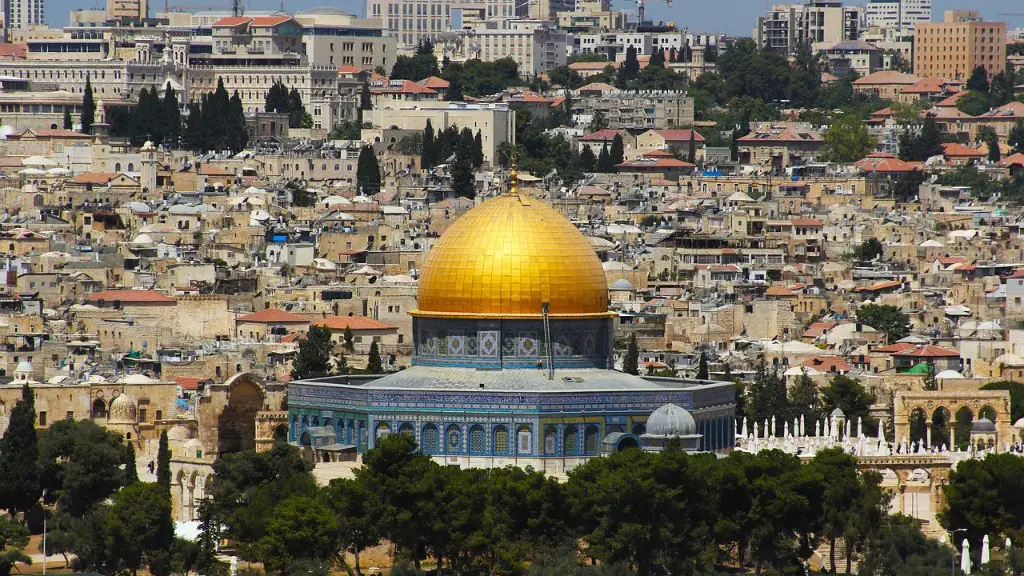Causes and Contributory Factors
The differences that led to the definitive break between Judaism and Christianity are complex and have been debated for centuries. It is widely accepted among scholars that this was a process that unfolded over time, rather than the result of one particular event. While there are many opinions on the causes and contributing factors, key events and trends that helped shape this divide can be identified.
One factor that is frequently cited in relation to this break is the destruction of Jerusalem in 70 AD. The destruction of Jerusalem was a devastating event for the Jewish people, who had long viewed the city as sacred and a symbol of their faith. This had a profound impact on their relationship with the Christian church which was becoming increasingly prominent in the Roman Empire at that time. The destruction of the city, often seen as an event of great punishment and suffering, was used by early Christian thinkers to make the case that their religion was a more appropriate mandate of faith.
Another key factor in the break between Judaism and Christianity was the escalating dispute over the validity of the Hebrew Bible. From the very beginning of its formation, the Christian church had a different interpretation of Scripture than what was accepted by the Rabbinic tradition of Judaism. This difference in opinion would cause further division as the Christian church began to assert its new positions, which were viewed as a threat by traditional Jewish scholars.
The rise of imperial Christianity also played a major role in the divide between the two religious traditions. As Christianity became more and more accepted and supported by the Roman Empire, it began to place emphasis on a fixed set of beliefs and practices that were regarded as essential for salvation. This challenged long-held Jewish beliefs, with an emphasis on ‘scriptural correctness’, as opposed to ‘rational truth’. As a result, Christian theologians began to develop their own version of a ‘biblical interpretation’ that contradicted traditional approaches.
J
Another factor was the separation of Christian and Jewish communities in Europe. The Church at the time was increasingly hostile towards Jewish traditions, which had already been creeping in. This trend was further strengthened by a series of regulations introduced by both Church and state in Europe over the next few centuries, effectively forcing Jewish communities to “live separately within their own quarters”. This form of social and political ‘apartheid’ further divided the two religious traditions and cemented the process of their separation.
Finally, it is important to mention the impact of the Crusades. In the 11th century, Pope Urban II declared a series of campaigns in the Middle East, with the aim of ‘reestablishing control’ over Jerusalem and other holy sites. This would result in vast destruction, both moral and physical, for Jewish communities and cement the divide between the two religions.
Impact of Inter-Religious Dialogue
Despite the long history of differences between Judaism and Christianity, over the last hundred years there have been significant efforts to bridge the divide between the two faiths. One example is the development of inter-religious dialogue and exchange, which has helped to bring some understanding and insight into the opposing views.
Interfaith dialogue has become increasingly common, with representatives from both faiths engaging in open and frank debates and exchanges over issues of faith and morality. This has allowed both sides to gain an understanding of the others’ beliefs, as well as a better appreciation of the differences and similarities between the two.
Some examples of successful efforts include the establishment of the Council of Christians and Jews in 1942, and the Vatican II gathering in 1965. The former was created to look at ways to build goodwill and understanding between the two religions, while the latter was a meeting of Christian representatives from all over the world to discuss and resolve differences in theology and liturgy.
The impact of these initiatives has been significant over the years, helping to create an atmosphere of mutual understanding and respect between Jews and Christians. This has led to greater collaboration and cooperation in various social and political fields, as well as greater acceptance of the beliefs and practices of the other. This has been vital in helping the two religious communities to remain in contact and even live together in peace.
Challenges to Interfaith Understanding
Despite the progress made through inter-religious dialogue, both Judaism and Christianity are still faced with many challenges. One of the major challenges is that both religions still have widely different views that can at times be difficult to reconcile. This is perhaps most apparent in relation to the Israeli-Palestinian conflict, which continues to divide the two communities.
The long and complex history of the region has meant that both sides have deeply entrenched views that can appear impossible to bridge, with tensions between the two sides often escalating and leading to violence. This tension is further exacerbated by the presence of global terrorism, with religious extremists from both sides exploiting the situation to further their own agendas.
In addition to this, there are also areas of cultural and religious differences which can often lead to misunderstanding. This includes issues such as dietary laws and gender roles, which have become increasingly divisive in recent years. These differences, while they are not insurmountable, can be alienating and difficult to bridge.
The Role of Education
One of the most effective ways to bridge the divide between Judaism and Christianity is through education. The development of interfaith schools, programs, and other initiatives has been a crucial step in this process.
These initiatives have focused on allowing individuals from both religious backgrounds to develop an understanding of the other’s faith and beliefs. They have also emphasized respect for the differences between the two traditions, while at the same time seeking to draw out the common elements that unite them.
By providing a constructive platform for dialogue, interfaith education initiatives have been key in bringing about positive change. Through learning about the other’s faith, communities have been able to move beyond simply tolerating each other, to fostering meaningful relationships of mutual understanding and respect.
Advancing Interfaith Relations
The future of interfaith relations between Judaism and Christianity is one that offers both potential and hope. In recent years there has been a greater emphasis on understanding and collaboration between the two traditions.
A key development has been the emergence of projects such as the Abrahamic Family Reunion, which seeks to bring together Jewish, Christian, and Muslim communities in the US and promote peace and understanding. This type of project has been both successful and inspiring, as it seeks to cultivate a sense of acceptance and tolerance between different religious groups.
At the same time, there has also been a more widespread acknowledgment of the importance of religious education and dialogue. This has resulted in the creation of projects such as the A Common Word Initiative, which seeks to promote dialogue between the three Abrahamic faiths. Through education and exchange, this type of project is hoping to create a more positive environment for meaningful conversations between the three traditions.
The Power of Community Engagement
Finally, it is important to look at the role of grassroots engagement in improving and developing interfaith understanding. In recent years, various community initiatives have been created to bring the Jewish and Christian communities together.
These initiatives have relied heavily on collaboration and participation from both sides. They have sought to foster respect, understanding, and ultimately, a sense of shared community. By helping to create a sense of common purpose and identity, these initiatives have offered a platform for meaningful dialogue and exchange.
Involving the local community can be a powerful tool in promoting interfaith understanding and fostering respect between different religions. It is a way to build bridges and provide a platform for greater understanding and dialogue between Jews and Christians.
The Role of The Media
The media can also play an important role in helping to advance interfaith understanding between the Jewish and Christian faiths. The media has often been used to portray the two religious communities in a positive light, as well as highlighting the importance of dialogue and collaboration.
In recent years, films, television shows, and books have sought to bring the two faiths together, offering an entertaining and informative platform to discuss religious themes. By giving both sides a platform to express their beliefs in a non-threatening way, the media can be an effective tool in building bridges between the two religious traditions.
In addition to this, there has also been an increase in media coverage of interfaith projects and initiatives. This has helped to raise public awareness of the various aspects of Judaism and Christianity, as well as the importance of understanding and collaboration between the two.
Conclusion
The definitive break between Judaism and Christianity was the product of a long and complex process involving a variety of factors. From the destruction of Jerusalem to the rise of imperial Christianity, a number of key events and trends helped to create this divide.
In more recent years, there has been an increased focus on interfaith understanding and exchange. Through education and dialogue, these initiatives have sought to bridge the divide between the two faiths and create an environment of greater acceptance and respect.
However, despite progress in this area, there are still many challenges facing both religions. Issues such as the Middle East conflict, cultural differences, and media representation continue to be major impediments to harmony and understanding.
Nevertheless, despite these challenges, both religions continue to work towards a common goal of understanding and cooperation. Through engagement and dialogue, there is still hope that the two faiths can come together and continue towards a more collaborative future.

